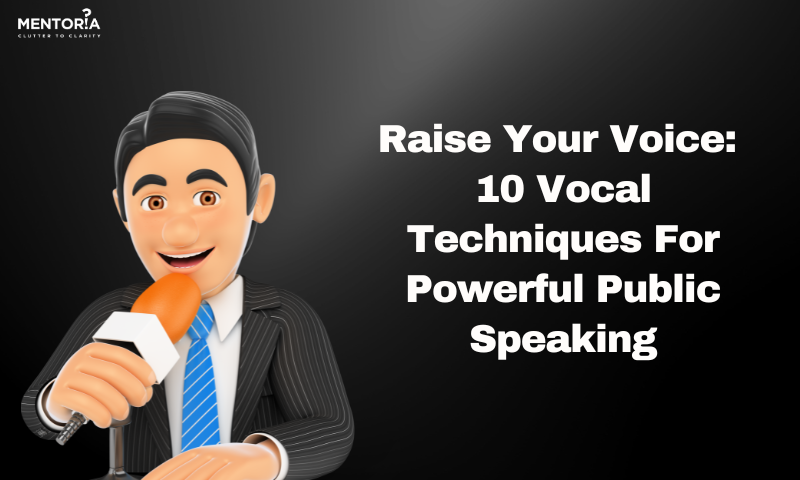Raise Your Voice: 10 Vocal Techniques For Powerful Public Speaking

Jump to Section
Have you ever wondered what sets apart a captivating speaker from a forgettable one? It’s all about the power of the voice! Whether you’re delivering a persuasive presentation, giving a TED talk, or simply addressing a crowd, mastering vocal techniques can elevate your public speaking game to new heights. In this blog, we’ll uncover ten vocal techniques that will transform your voice into a mesmerising instrument, captivating your audience’s attention from the moment you open your mouth. So, warm up those vocal cords, embrace your inner performer, and let’s embark on a journey to unleash the full potential of your voice for effective public speaking!
The Power Of Projection: Be Heard Loud And Clear!
Are you tired of straining to be heard? It’s time to project your voice with confidence! Discover techniques to engage your diaphragm, control your breath, and project your voice to the back of the room. Whether you’re speaking to a small group or a large audience, you’ll grab attention and leave a lasting impact with your powerful voice.
- Diaphragmatic Breathing: Diaphragmatic breathing, also known as belly breathing, is a technique that involves engaging the diaphragm to promote deep, controlled breaths. To engage your diaphragm, place one hand on your abdomen and inhale deeply, allowing your belly to rise as you fill your lungs with air. Exhale slowly, feeling your belly lower. This technique helps activate and strengthen the diaphragm, improving breathing efficiency and vocal projection.
- Vocal Exercises: Certain vocal exercises can help engage the diaphragm and promote better control over your voice. One effective exercise is the “Siren” exercise, where you start at a low pitch and gradually slide your voice up to a higher pitch and back down again. This exercise encourages the use of the diaphragm and helps expand your vocal range.
- Yoga and Pilates: Engaging in activities like yoga and Pilates can also help strengthen the diaphragm and improve its function. These practices often emphasise deep breathing and core engagement, which indirectly targets the diaphragm. Exercises such as the “Hundred” in Pilates and various breathing techniques in yoga can promote diaphragmatic engagement and overall breath control.
By incorporating these techniques into your vocal and breathing exercises, you can develop a stronger connection with your diaphragm and improve your ability to control your voice and engage your audience effectively.
Mastering Pace And Pause: The Art Of Rhythm In Speech
Speech is like a dance, and rhythm is its beat. Learn the art of pacing your speech and strategically incorporating pauses for emphasis and impact. Explore the power of silence and let it speak volumes. By mastering pace and pause, you’ll create a captivating and engaging delivery that keeps your audience on the edge of their seats.
- Practice Timing and Rhythm: One technique for mastering pace and pause is to practise timing and rhythm during your speech or presentation. Pay attention to the natural flow of your words and sentences, and aim for a consistent and appropriate pace. Practice delivering your content at different speeds to find the right balance. Use a stopwatch or timer to track your timing and make adjustments as needed.
- Emphasise Key Points with Pauses: Pauses can be used strategically to emphasise important points and allow them to sink in with your audience. When you reach a significant point or want to create anticipation, pause briefly before continuing. This gives your audience time to process the information and adds impact to your message. Experiment with different lengths of pauses to find what works best for the content and tone of your presentation.
- Use Vocal Inflection and Variation: Another technique for mastering pace and pause is to incorporate vocal inflection and variation. Varying your tone, pitch, and volume can help add interest and engagement to your speech. Use pauses in conjunction with vocal inflection to create emphasis and convey meaning. Practice modulating your voice and experimenting with different patterns of pacing and pausing to keep your audience engaged and attentive.
Remember, mastering pace and pause is a skill that comes with practice and experience. By being mindful of your delivery, practising timing and rhythm, and using pauses strategically, you can enhance your overall speaking ability and effectively engage your audience.
Taming The Tension: Unlocking Vocal Relaxation
Are you plagued by vocal tension? It’s time to loosen up and find your vocal freedom! Do exercises to relax your jaw, neck, and throat. Release tension, embrace your natural voice, and speak with ease. By unlocking vocal relaxation, you’ll project confidence and authenticity, captivating your audience with every word.
- Jaw Relaxation Exercise: Start by gently opening your mouth and allowing your jaw to relax. Place the tip of your tongue behind your upper front teeth and let your jaw hang loose. Slowly move your jaw from side to side, feeling the muscles in your jaw release any tension. Repeat this movement several times, focusing on keeping your jaw relaxed throughout.
- Neck Stretch: Sit or stand with a straight posture. Slowly tilt your head to one side, bringing your ear towards your shoulder. Hold the stretch for a few seconds, feeling the gentle stretch along the side of your neck. Repeat on the other side. Next, lower your chin towards your chest and hold for a few seconds, feeling the stretch in the back of your neck. Finally, tilt your head back and look up towards the ceiling, stretching the front of your neck. Repeat these stretches a few times, focusing on maintaining a relaxed and steady breath.
- Throat Release Exercise: Sit or stand with good posture and take a deep breath in. As you exhale, make a low “ahh” sound, allowing your throat to fully open and relax. Repeat this sound a few times, focusing on the feeling of the vibration and relaxation in your throat. You can also gently massage the muscles at the front of your throat with your fingertips in a circular motion to further release tension.
These exercises can help alleviate tension in your jaw, neck, and throat, promoting relaxation and reducing any discomfort or stiffness you may be experiencing. Remember to listen to your body and stop any exercise that causes pain or discomfort.
Pitch Perfect: Harnessing The Power Of Vocal Range
The magic of voice lies in its versatility. Explore the power of pitch variation to convey emotion and captivate your audience. From high notes of excitement to low tones of seriousness, your vocal range is a palette of colours waiting to be explored. Embrace the full spectrum of your voice and paint a vivid picture with your words.
Imagine you’re giving a motivational speech. By utilising pitch variation, you’re able to inject enthusiasm and energy into your delivery, motivating your audience to take action and pursue their dreams.
- Siren Exercise: Begin by smoothly gliding your voice from your lowest pitch to your highest pitch and back down again, resembling the sound of a siren. This exercise helps you explore and expand your vocal range, allowing you to have better control over your pitch and explore different tones.
- Vocal Fry Exercise: Practise producing a low-pitched, creaky sound by deliberately engaging your vocal fry. This exercise helps strengthen your vocal cords and improve pitch stability, enabling you to hit lower notes with clarity and control.
- Lip Trills: Close your lips and produce a buzzing sound as you exhale slowly. This exercise helps relax and warm up your vocal cords, enhancing your pitch accuracy and control. It also aids in improving breath control and sustaining notes effortlessly.
Articulation Excellence: Enunciate And Articulate With Precision
Clear communication is key to effective public speaking. Explore exercises to enhance your enunciation and articulation, ensuring every word is crisp and easily understood. Master the art of pronunciation, clarity, and diction, leaving no room for misinterpretation. Enunciate like a pro and command attention with your impeccable speech.
- Tongue Twisters: Challenge yourself with tongue twisters that focus on specific sounds or letter combinations. Repeat them slowly and gradually increase your speed. This exercise improves clarity and precision in articulation, helping you pronounce words more accurately.
- Consonant Articulation Exercises: Practise exaggerating and isolating specific consonant sounds, such as “t,” “d,” and “s.” Pay attention to the placement of your tongue and the clarity of the sound. This exercise improves diction and enhances the overall intelligibility of your speech.
- Reading Aloud: Choose passages or texts with varying levels of complexity and read them aloud with emphasis on clear and precise articulation. This exercise helps you develop better control over your mouth muscles and improve your overall speech clarity.
Emotional Resonance: Infusing Your Voice With Emotion
Your voice is a powerful vehicle for emotion. Learn to infuse your words with genuine feeling to create an emotional resonance with your audience. Whether it’s joy, empathy, or determination, let your voice reflect your authentic emotions. By connecting on an emotional level, you’ll establish a deep rapport and leave a lasting impact.
- Emotional Recall: Tap into personal experiences or memories that evoke specific emotions. Practice expressing those emotions through your voice, allowing the feelings to resonate in your tone, pace, and inflection. This exercise helps you develop authenticity and emotional depth in your delivery.
- Vocal Characterisation: Experiment with embodying different characters or personas and expressing their emotions through your voice. Explore the nuances of tone, rhythm, and volume to convey the intended emotions convincingly.
- Visualisation Technique: Before speaking, mentally visualise the emotions you want to convey and imagine how they would manifest in your voice. Focus on connecting with the emotional essence of your message and channelling it through your vocal expression.
Masterful Intonation: Conveying Meaning Through Tone
Intonation is the secret sauce that adds flavour to your speech. Learn how to use variations in tone to emphasise key points, create suspense, and convey meaning. Whether it’s a rise in tone for a question or a fall for a powerful statement, your intonation will guide your audience’s understanding and engagement.
- Phrase Emphasis: Practise emphasising different words or phrases in a sentence to alter the intended meaning. Experiment with various tonal patterns to convey different shades of emphasis and highlight the key elements of your message.
- Rising and Falling Inflection: Explore using rising inflection to indicate a question or uncertainty and falling inflection to convey a statement or certainty. Practice modulating your voice to create natural and engaging intonation patterns.
- Dynamic Pacing: Experiment with varying the speed and rhythm of your speech to reflect the emotional content and importance of different parts of your message. Use pauses and changes in pace to add emphasis and maintain listener engagement.
Dynamic Volume Control: The Soft And Loud Of Impactful Speaking
Volume control is your secret weapon for impactful speaking. Explore techniques to adjust your volume, from soft whispers to powerful proclamations. Use volume to create emphasis, build suspense, and engage your audience in a dynamic journey. Harness the power of volume and watch as your words reverberate in the hearts and minds of your listeners.
- Whisper Exercise: Practise speaking softly and clearly, making sure your words are still intelligible. Focus on maintaining clarity and projection, even at lower volumes. This exercise helps develop control over your breath and vocal muscles for effective soft-speaking techniques.
- Vocal Projection: Practise speaking with a strong and confident voice, projecting your sound to fill the space around you. Focus on maintaining good posture, engaging your diaphragm, and using appropriate breath support to produce a powerful and resonant voice.
- Volume Variation: Explore the power of contrast by intentionally varying your volume levels throughout your speech. Experiment with softer moments.
Authenticity Amplification: Embracing Your Unique Voice
In a world of imitators, authenticity is a breath of fresh air. Embrace your unique voice and let it shine through your speaking. Discover techniques to unleash your natural vocal qualities, quirks, and personality. By amplifying your authenticity, you’ll connect with your audience on a genuine level, leaving a memorable impression.
- Self-Reflection: Take time to understand and embrace your natural speaking voice. Reflect on your own vocal qualities, strengths, and unique characteristics. Embrace your individuality and avoid imitating others. This will help you develop a confident and authentic speaking style.
- Authentic Storytelling: Share personal experiences and stories that reflect your true self. Connect with your audience by being genuine and relatable. Allow your voice to convey the emotions and authenticity behind your stories, creating a stronger connection with your listeners.
- Self-Acceptance: Embrace your voice as a part of your identity. Celebrate its uniqueness and avoid comparing yourself to others. Practice self-acceptance and develop a positive mindset towards your own vocal abilities. This will enable you to speak with confidence and authenticity.
The Secret Of Vocal Warm-Ups: Preparing Your Instrument
Just like a musician tunes their instrument, you must warm up your voice before speaking. Explore vocal warm-up exercises to relax your muscles, improve vocal agility, and prepare your instrument for a stellar performance. From tongue twisters to vocal sirens, these warm-ups will unleash the full potential of your voice.
- Lip Trills and Buzzing: Perform lip trills and buzzing exercises to warm up your lips, tongue, and facial muscles. This helps to improve articulation, flexibility, and overall vocal control.
- Tongue and Jaw Exercises: Engage in tongue and jaw exercises, such as tongue stretches and jaw rotations, to release tension and promote relaxation in these areas. This aids in improving clarity of speech and reducing vocal strain.
- Vocal Sirens: Practise vocal sirens, gliding your voice smoothly from the lowest to the highest pitch and vice versa. This exercise helps to warm up your vocal folds, expand your range, and promote vocal flexibility.
Master Vocal Techniques With Mentoria!
By mastering these ten vocal techniques, you have unlocked the key to powerful public speaking. Embrace the power of projection, pace, relaxation, pitch, articulation, emotion, intonation, volume, authenticity, and warm-ups. Infuse your words with magic and captivate your audience with the sheer force of your voice. So, step onto the stage, own your unique sound, and let your voice be the symphony that resonates in the hearts of all who listen.
We’re here to provide you with all the help! Kick-start your journey with Mentoria and discover the right fit for you. Feel free to call us to speak to our career mentors and choose the right guidance plan that suits your needs.
Mentoria’s career guidance programme enables you to choose your perfect fit from 3 streams, 850+ courses, and 12,000+ careers, and discover what will bring out the best in you.









